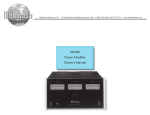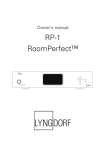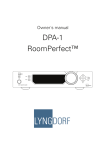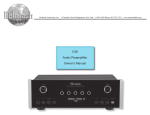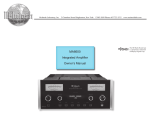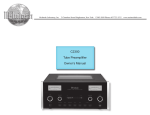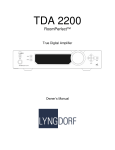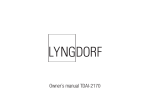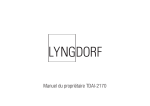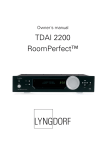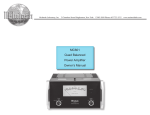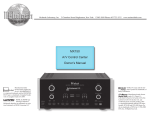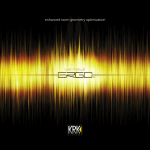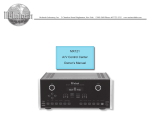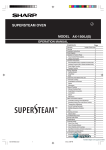Download McIntosh MEN220 audio amplifier
Transcript
McIntosh Laboratory, Inc. Manufactured under license from Lyngdorf Audio A/S. ROOMPERFECT is a registered trademark and the ROOMPERFECT logo is a trademark of Lyngdorf Audio A/S. (C) Lyngdorf Audio A/S 2009. 2 Chambers Street Binghamton, New York MEN220 Room Correction System Owner’s Manual 13903-2699 Phone: 607-723-3512 www.mcintoshlabs.com The lightning flash with arrowhead, within an equilateral triangle, is intended to alert the user to the presence of uninsulated “dangerous voltage” within the product’s enclosure that may be of sufficient magnitude to constitute a risk of electric shock to persons. WARNING - TO REDUCE RISK OF FIRE OR ELECTRICAL SHOCK, DO NOT EXPOSE THIS EQUIPMENT TO RAIN OR MOISTURE. IMPORTANT SAFETY INSTRUCTIONS! PLEASE READ THEM BEFORE OPERATING THIS EQUIPMENT. 1. Read these instructions. 2. Keep these instructions. 3. Heed all warnings. 4. Follow all instructions. 5. Do not use this apparatus near water. 6. Clean only with a dry cloth. 7. Do not block any ventilation openings. Install in accordance with the manufacturer’s instructions. 8. Do not install near any heat sources such as radiators, heat registers, stoves, or other apparatus (including amplifiers) that produce heat. 9. Do not defeat the safety purpose of the polarized or grounding-type plug. A polarized plug has two blades with one wider than the other. A grounding type plug has two blades and a 2 The exclamation point within an equilateral triangle is intended to alert the user to the presence of important operating and maintenance (servicing) instructions in the literature accompanying the appliance. NO USER-SERVICEABLE PARTS INSIDE. REFER SERVICING TO QUALIFIED PERSONNEL. third grounding prong. The wide blade or the third prong are provided for your safety. If the provided plug does not fit into your outlet, consult an electrician for replacement of the obsolete outlet. 10. Protect the power cord from being walked on or pinched particularly at plugs, convenience receptacles, and the point where they exit from the apparatus. 11. Only use attachments/accessories specified by the manufacturer. 12. Use only with the cart, stand, tripod, bracket, or table specified by the manufacturer, or sold with the apparatus. When a cart is used, use caution when moving the cart/ apparatus combination to avoid injury from tip-over. 13. Unplug this apparatus during lightning storms or when unused for long periods of time. 14. Refer all servicing to qualified service personnel. Servicing is required when the apparatus has been damaged in any way, such as power- To prevent the risk of electric shock, do not remove cover or back. No user-serviceable parts inside. supply cord or plug is damaged, liquid has been spilled or objects have fallen into the apparatus, the apparatus has been exposed to rain or moisture, does not operate normally, or has been dropped. 15. Do not expose this equipment to dripping or splashing and ensure that no objects filled with liquids, such as vases, are placed on the equipment. 16. To completely disconnect this equipment from the a.c. mains, disconnect the power supply cord plug from the a.c. receptacle. 17. The mains plug of the power supply cord shall remain readily operable. 18. Do not expose batteries to excessive heat such as sunshine, fire or the like. 19. Connect mains power supply cord only to a mains socket outlet with a protective earthing connection. Thank You Your decision to own this McIntosh MEN220 Room Correction System ranks you at the very top among discriminating music listeners. You now have “The Best.” The McIntosh dedication to “Quality,” is assurance that you will receive many years of musical enjoyment from this unit. Please take a short time to read the information in this manual. We want you to be as familiar as possible with all the features and functions of your new McIntosh. Please Take A Moment The serial number, purchase date and McIntosh Dealer name are important to you for possible insurance claim or future service. The spaces below have been provided for you to record that information: Serial Number:________________________________ Purchase Date:_ _______________________________ Dealer Name:_ ________________________________ Technical Assistance If at any time you have questions about your McIntosh product, contact your McIntosh Dealer who is familiar with your McIntosh equipment and any other brands that may be part of your system. If you or your Dealer wish additional help concerning a suspected problem, you can receive technical assistance for all McIntosh products at: McIntosh Laboratory, Inc. 2 Chambers Street Binghamton, New York 13903 Phone: 607-723-3512 Fax: 607-724-0549 Customer Service If it is determined that your McIntosh product is in need of repair, you can return it to your Dealer. You can also return it to the McIntosh Laboratory Service Department. For assistance on factory repair return procedure, contact the McIntosh Service Department at: McIntosh Laboratory, Inc. 2 Chambers Street Binghamton, New York 13903 Phone: 607-723-3515 Fax: 607-723-1917 General Information 1. For additional connection information, refer to the owner’s manual(s) for any component(s) connected to the MEN220 Room Correction System. 2. The Main AC Power going to the MEN220 and any other McIntosh Component(s) should not be applied until all the system components are connected together. Failure to do so could result in malfunctioning of some or all of the system’s normal operations. When the MEN220 and other McIntosh Components are in their Standby Power Off Mode, the Microprocessor’s Circuitry inside each component is active and communication is occurring between them. 3. Sound Intensity is measured in units called Decibels and “dB” is the abbreviation. 4. When discarding the unit, comply with local rules or regulations. Batteries should never be thrown away or incinerated but disposed of in accordance with the local regulations concerning battery disposal. 5. For additional information on the MEN220 and other McIntosh Products please visit the McIntosh Web Site at www.mcintoshlabs.com. Copyright 2010 © by McIntosh Laboratory, Inc. 3 Table of Contents Safety Instructions...................................................... 2 Thank You and Please Take a Moment....................... 3 Technical Assistance and Customer Service.............. 3 General Information................................................... 3 Table of Contents........................................................ 4 Connector and Cable Information.............................. 4 Introduction................................................................. 5 Performance Features................................................. 5 Dimensions................................................................. 6 Installation.................................................................. 7 Connections: Rear Panel Connections.............................................. 8 How to Connect the MEN220............................... 9-12 Remote Control: Remote Control Push-buttons................................... 14 How to use the Remote Control................................ 15 Front Panel: Front Panel Displays, Controls and Push-buttons..... 16 Setup: How to Operate the Setup Mode.............................. 17 Default Settings........................................................ 17 Input Connection Settings........................................ 18 System Connection Settings..................................... 18 Output Settings......................................................... 19 Advanced Settings.................................................... 22 RoomPerfect............................................................. 24 Operation: How to Operate the MEN220.............................. 28-29 Additional Information: Specifications............................................................ 30 Packing Instruction................................................... 31 4 Connector and Cable Information XLR Connectors Below is the Pin configuration for the XLR Balanced Output Connectors on the MEN220. Refer to the diagrams for connections: PIN 1: Shield/Ground PIN 2: + Signal PIN 3: - Signal PIN 1 PIN 2 PIN 2 PIN 1 PIN 3 PIN 3 Power Control Connectors The MEN220 Power Control Input/Output Jacks receive/send Power On/Off Power Control Signals when connected to Meter other McIntosh Components. A Illumination Control 1/8 inch stereo mini phone plug Pass Thru is used for connection to the Ground Power Control Input/Output on the MEN220. Note: The Data and Power Control Connecting Cable is available from the McIntosh Parts Department: Data and Power Control Cable Part No. 170-202 Six foot, shielded 2 conductor, with 1/8 inch stereo mini phone plugs on each end. Data and IR Input Port Connectors The MEN220 Data In Port receives Remote Control Signals. A Data 1/8 inch stereo mini phone plug is Signal N/C used for connection. The IR Port Data also use a 1/8 inch stereo mini Ground phone plug and allow the connection of other brand IR Receivers IR Data to the MEN220. Control N/C Ground RS232 DB9 Connector Pin Layout 1. N/C 6. N/C 2. Data Out (TXD) 7. N/C 3. Data In (RXD) 8. N/C 4. N/C 9. N/C 5. Gnd. Microphone XLR Connectors Below is the Pin configuration for the Microphone Connector on the MEN220. Refer to the diagram for connections: PIN 1: Shield/Ground PIN 2: Signal PIN 3: +8.9VDC PIN 2 PIN 1 PIN 3 General Information, Cable Information, Introduction and Performance Features Introduction The MEN220 Room Correction System is an elegant instrument for restoring superb sound reproduction to your audio system by measuring and correcting for less than ideal room acoustics. The MEN220 uses the latest in technology to quickly restore proper musical balance in a minimum amount of time. The McIntosh Sound is “The Sound of the Music Itself.” Performance Features • Precision Measurement Microphone The MEN220 is supplied with an Omnidirectional Electret Condenser Microphone to accurately measure the Loudspeaker performance together with Room Acoustics. The microphone has high resistance to vibrations, flat frequency response and a high signal-tonoise ratio. It is “phantom power” from the MEN220 via the balanced cable. • Room Correction The MEN220 uses the latest in technology to restore musical balance to audio systems located in rooms with less then ideal acoustics, whether the system is two channel or multichannel. • Professional Microphone Stand with Boom The MEN220 is supplied with a professional type adjustable height microphone stand. The Boom Adapter allows for easy placement of the Precision Microphone for precise Focus Measurements. • Focus and Global Settings The MEN220 provides for measurement and correction for up to eight specific listening locations (Focus Positions) in a room. It also measures additional locations in the room and produces a Global Room Correction for listening anywhere in the room. • Multiple Outputs The MEN220 has both Unbalanced and Balanced Outputs of which permit long cable lengths without a loss in sound quality. • Electronic Crossover The advanced two way electronic crossover built into the MEN220 provides the best way for adding true biamplification to your audio system. • Variable Crossover Settings The variable crossover in the MEN220 allows the crossover frequency to be set from 10Hz to 20,000Hz. Select from three available crossover slope rates for both the Butterworth or Linkwitz-Riley Filter Types. • Listening Equalization Curves The MEN220 has six preset Equalization Curves to choose from when listening to various type of music. • Extruded Side Panels The sides of the MEN220 are extruded aluminum panels with a bead blast textured surface and a black anodized finish. • Fiber Optic Solid State Front Panel Illumination The Illumination of the Glass Front Panel is accomplished by the combination of custom designed Fiber Optic Light Diffusers and extra long life Light Emitting Diodes (LEDs). This provides even Front Panel Illumination and is designed to ensure the pristine beauty of the MEN220 will be retained for many years. • Multi-Function Front Panel Display The Front Panel Information Display indicates various setup and operational functions. • Power Control and Full Function Remote Control The Power Control Input connection provides convenient Turn-On/Off of the MEN220 when connected to a McIntosh System. The Remote Control push-buttons provide complete control of the MEN220 operating functions. • Special Power Supply The Power Supply has both a special large Toroidal Wound Power Transformer and Multiple Regulators to ensure stable noise free operation even though the power line varies. 5 Dimensions Dimensions The following dimensions can assist in determining the best location for your MEN220. Front View of the MEN220 17-1/2" 44.45cm RoomPerfect:Focus 1 Voicing 0:Neutral 5-3/8" 13.69cm 6" 15.24cm Side View of the MEN220 15-7/8" 40.32cm 5/8" 1.59cm 14-1/2" 36.83cm 3/16" 0.48cm Rear View of the MEN220 17" 13/16" 2.06cm 43.18cm 2" 4-5/8" 11.75cm 13-1/4" 33.65cm 6 5.08cm 10-9/16" 26.83cm 1-15/16" 4.92cm 4-13/16" 12.22cm Installation Installation The MEN220 can be placed upright on a table or shelf, standing on its four feet. It also can be custom installed in a piece of furniture or cabinet of your choice. The four feet may be removed from the bottom of the MEN220 when it is custom installed as outlined below. The four feet together with the mounting screws should be retained for possible future use if the MEN220 is removed from the custom installation and used free standing. The required panel cutout, ventilation cutout and unit dimensions are shown. Always provide adequate ventilation for your MEN220. Cool operation ensures the longest possible operating life for any electronic instrument. Do not install the MEN220 directly above a heat generating component such as a high powered amplifier. If all the components are installed in a single cabinet, a quiet running ventilation fan can be a definite asset in maintaining all the system components at the coolest possible operating temperature. When the MEN220 is placed free-standing on a flat surface, allow at least 2 inches (5.08cm) above the top, 2 inches (5.08cm) below the bottom and 2 inches (5.08cm) on each side of the MEN220, so airflow is not obstructed. Allow 19-1/2 inches (49.53cm) depth behind the front panel. Allow 1-7/16 inch (3.66cm) in front of the mounting panel for knob clearance. A custom cabinet installation should provide the minimum spacing dimensions for cool operation. Allow at least 2 inches (5.08cm) above the top, 2 inches (5.08cm) below the bottom and 2 inches (5.08cm) on each side of the MEN220, so airflow is not obstructed. The Custom Cabinet should be open backed and at least 12 inches (30.48cm) away from any surface such as a wall. Be sure to cut out a ventilation hole in the mounting shelf according to the dimensions in the drawing. Allow 1-7/16 inch (3.66cm) in front of the mounting panel for knob clearance. 17-1/16" 43.34cm MEN220 Front Panel Custom Cabinet Cutout 4-7/8" 12.38cm RoomPerfect:Focus 1 Voicing 0:Neutral Cabinet Front Panel Cutout Opening for Custom Mounting Cabinet Front Panel 2" 5.08cm MEN220 Side View in Custom Cabinet Custom Cabinet has an open back and at least 12” (30.48cm) away from any surface such as a wall Cutout Opening for Ventilation Support Shelf 1" MEN220 Bottom View in Custom Cabinet 2.54cm Chassis Spacers 1-1/8" 2.86cm 11" 27.94cm 15" 38.1cm 15" 38.1cm Cutout Opening for Ventilation 1-3/4" 4.45cm Note: Center the cutout Horizontally on the unit. For purposes of clarity, the above illustration is not drawn to scale. 12-5/16" 31.27cm 7 Rear Panel Connections POWER CONTROL IN receives signals from a McIntosh component (5-15 Volts ON, 0 Volts OFF). POWER CONTROL OUT sends out a (12 Volts ON) signal to another McIntosh Component when the MEN220 is On RS232 connector for communications with an external control device DATA IN receives operating data from a McIntosh Preamplifier or Control Center Connect the MEN220 power cord to a live AC outlet. Refer to information on the back panel of your MEN220 to determine the correct voltage for your unit UNBALanced AUDIO INPUTS receive audio signals from a Preamplifier or an A/V Control Center Connect the MEN220 Calibrated Microphone with the supplied cable IR INput for connecting an IR Receiver 8 Unbalanced OUTPUT 1 (HIGH) supplies Full Range or High Frequency audio signals to a Power Amplifier Balanced OUTPUT 1 (HIGH) supplies Full Range or High Frequency audio signals to a Power Amplifier Unbalanced OUTPUT 2 (LOW) supplies Full Range or Low Frequency audio signals to a Power Amplifier BALanced AUDIO INPUTS receive audio signals from a Preamplifier or an A/V Control Center Balanced OUTPUT 2 (LOW) supplies Full Range or Low Frequency audio signals to a Power Amplifier How to Connect the MEN220 How to Connect the MEN220 The MEN220 has the ability to be remotely switched On/Off from a Preamplifier or A/V Control Center via the Power Control connection. The Data Port Connection allows for the remote operation of basic functions using the MEN220 Remote Control. With an external sensor connected to the MEN220, remote control operation is possible from another room and/or when the MEN220 is located in a cabinet with the doors closed. The connection instructions below, together with the MEN220 Connection Diagram “Mc1A” located on the separate folded sheet, is an example of a typical audio system. Your system may vary from this, however the actual components would be connected in a similar manner. For additional information refer to “Connector and Cable Information” on page 4. Power Control Connections: 1. Connect a Control Cable from the Preamplifier or A/V Control Center Power Control MAIN Jack to the POWER CONTROL IN Jack on the McIntosh MEN220. 2. Connect a Control Cable from the MEN220 POWER CONTROL OUT Jack to the Power Amplifier 1 Power Control In Jack. 3. Connect a Control Cable from the Power Amplifier 1 Power Control Out Jack to the Power Amplifier 2 Power Control In Jack. 4. Connect any additional components in a similar manner, as outlined in steps 2 thru 3. Data Control Connections: 5. Connect a Control Cable from the Preamplifier or A/V Control Center SUM Data Port Jack to the McIntosh MEN220 DATA IN Jack. Note: If the Preamplifier or A/V Control Center doesn’t have a SUM Data Port Jack, contact McIntosh for additional assistance. Sensor Connections: 6. Connect an external Sensor to the McIntosh MEN220 IR IN Jack. Audio Connections: 7. Connect Balanced Cables from the McIntosh MEN220 BALanced AUDIO INPUT Connectors to the Preamplifier or A/V Control Center Balanced Output Jacks. Notes: 1. The Unbalanced Outputs on the MEN220 may be used instead of the Balanced Connections. 2. By default the Unbalanced Inputs are the active Connections. To use the Balanced Inputs instead, it is first necessary to change the default setting using the MEN220 Setup Mode. Refer to pages 17 and 18. 8. Connect a Balanced Cable from the MEN220 Balanced AUDIO OUTPUT (1) R Connector to the Power Amplifier 1 Balanced Input Connector. Note: The Unbalanced and Balanced Output Connections are both active and may be used at the same time. 9. Connect a Balanced Cable from the MEN220 Balanced AUDIO OUTPUT (1) L Connector to the Power Amplifier 2 Balanced Input Connector. Loudspeaker Connections: 10. Refer to the Owner’s Manuals supplied with the Power Amplifier and Loudspeakers for connection information. AC Power Cords Connections: 11. Connect the McIntosh MEN220 AC Power Cord to a live AC outlet. 9 How to Connect the MEN220 in a Processor Loop How to Connect the MEN220 in a Processor Loop The MEN220 may be connected to the Listen Processor Loop on a McIntosh Preamplifier or A/V Control Center, instead of being connected between the Preamplifier Output and Power Amplifier Input. The MEN220 has the ability to be remotely switched On/Off from a Preamplifier or A/V Control Center via the Power Control connection. The Data Port Connection allow for the remote operation of basic functions using the MEN220 Remote Control. With an external sensor connected to the MEN220, remote control operation is possible from another room and/or when the MEN220 is located in a cabinet with the doors closed. The connection instructions below, together with the MEN220 Connection Diagram located on the separate folded sheet “Mc1B” is an example of a typical audio system. Your system may vary from this, however the actual components would be connected in a similar manner. For additional information refer to “Connector and Cable Information” on page 4. Power Control Connections: 1. Connect a Control Cable from the Preamplifier or A/V Control Center Power Control MAIN Jack to the POWER CONTROL IN Jack on the McIntosh MEN220. 2. Connect a Control Cable from the MEN220 POWER CONTROL OUT Jack to the Power Amplifier 1 Power Control In Jack. 3. Connect a Control Cable from Power Amplifier 1 Power Control Out Jack to the Power Amplifier 2 Power Control In Jack. 4. Connect any additional components in a similar manner, as outlined in steps 2 thru 3. Data Control Connections: 5. Connect a Control Cable from the Preamplifier or 10 A/V Control Center SUM Data Port Jack to the McIntosh MEN220 DATA IN Jack. Note: If the Preamplifier or A/V Control Center doesn’t have a SUM Data Port Jack, contact McIntosh for additional assistance. Sensor Connections: 6. Connect an external Sensor to the McIntosh MEN220 IR IN Jack. Audio Connections: 7. Connect Audio Cables from the McIntosh MEN220 UNBALanced AUDIO INPUT Connectors to the Preamplifier or A/V Control Center Processor (Listen) TO Output Jacks. 8. Connect Audio Cables from the MEN220 UNBALanced AUDIO OUTPUT 1 (High) R Connector to the Preamplifier or A/V Control Center Processor (Listen) Right Channel FROM Input Jacks. 9. Connect Audio Cables from the MEN220 UNBALanced AUDIO OUTPUT 1 (High) L Connector to the Preamplifier or A/V Control Center Processor (Listen) Right Channel FROM Input Jacks. 10. Connect a Balanced Cable from the Preamplifier or A/V Control Center Right Channel Main Output to Power Amplifier 1 Balanced Input. 11. Connect a Balanced Cable from the Preamplifier or A/V Control Center Left Channel Main Output to Power Amplifier 2 Balanced Input. Loudspeaker Connections: 12. Refer to the Owner’s Manuals supplied with the Power Amplifier and Loudspeakers for connection information. AC Power Cords Connections: 13. Connect the McIntosh MEN220 AC Power Cord to a live AC outlet. How to Connect the MEN220 with Crossover How to Connect the MEN220 with Crossover The MEN220 has a built-in Electronic Crossover Network with an adjustable Crossover Frequency. It also has the ability to be remotely switched On/Off from a McIntosh Preamplifier or A/V Control Center via the Power Control connection. The Data Port Connection allow for the remote operation of basic functions using the MEN220 Remote Control. With an external sensor connected to the MEN220, remote control operation is possible from another room and/ or when the MEN220 is located in a cabinet with the doors closed. The connection instructions below, together with the MEN220 Connection Diagram located on the separate folded sheet “Mc2A” is an example of a typical audio system. Your system may vary from this, however the actual components would be connected in a similar manner. For additional information refer to “Connector and Cable Information” on page 4. Power Control Connections: 1. Connect a Control Cable from the Preamplifier or A/V Control Center Power Control MAIN Jack to the POWER CONTROL IN Jack on the McIntosh MEN220. 2. Connect a Control Cable from the MEN220 POWER CONTROL OUT Jack to the Power Amplifier 3 Power Control In Jack. 3. Connect a Control Cable from Power Amplifier 3 Power Control Out Jack to the Power Amplifier 1 Power Control In Jack. 4. Connect a Control Cable from Power Amplifier 1 Power Control Out Jack to the Power Amplifier 2 Power Control In Jack. 5. Connect any additional components in a similar manner, as outlined in steps 2 thru 3. Data Control Connections: 6. Connect a Control Cable from the Preamplifier or A/V Control Center SUM Data Port Jack to the McIntosh MEN220 DATA IN Jack. Note: If the Preamplifier or A/V Control Center doesn’t have a SUM Data Port Jack, contact McIntosh for additional assistance. Sensor Connections: 7. Connect an external Sensor to the McIntosh MEN220 IR IN Jack. Audio Connections: 8. Connect Balanced Cables from the McIntosh MEN220 BALanced AUDIO INPUT Connectors to the Preamplifier or A/V Control Center Balanced Output Jacks. Notes: 1. The Unbalanced Outputs on the MEN220 may be used instead of the Balanced Connections. 2. By default the Unbalanced Inputs are the active Connections. To use the Balanced Inputs instead, it is first necessary to change the default setting using the MEN220 Setup Mode. Refer to pages 17 and 18. 9. Connect a Balanced Cable from the MEN220 Balanced AUDIO OUTPUT (1) (High Pass) R Connector to Power Amplifier 3 Balanced Input R Connector. Note: The Unbalanced and Balanced Output Connections are both active and may be used at the same time. 10. Connect a Balanced Cable from the MEN220 Balanced AUDIO OUTPUT (1) (High Pass) L Connector to Power Amplifier 3 Balanced Input L Connector. 11. Connect a Balanced Cable from the MEN220 Balanced AUDIO OUTPUT (2) (Low Pass) R Connector to Power Amplifier 3 Balanced Input Connector. 12. Connect a Balanced Cable from the MEN220 Balanced AUDIO OUTPUT (2) (Low Pass) L Connector to Power Amplifier 2 Balanced Input Connector. Loudspeaker Connections: The following Loudspeaker Connection instructions are based on the Crossover Settings outlined in the Setup Section in this Owner’s Manual. Refer to pages 19 and 20 for additional information. 13. Refer to the Owner’s Manuals supplied with the Power Amplifier and Loudspeakers for information on connecting Power Amplifiers 1 and 2 to the Low Frequency Section of the Loudspeakers. When the Electronic Crossover Circuitry in the MEN220 is active. It is important the sound coming from the Low Frequency Section of the Loudspeaker be in “Acoustical Phase” with the sound from the High Frequency Section of the Loudspeaker. The connections between Power Amplifier 3 and the High Frequency Section of the Loudspeakers need the electrical connection phase reversed at the Loudspeaker High Frequency Section Terminals. This reversed phase connection will achieve the correct “Acoustical Phase” from the Loudspeaker System. 14. Connect COM (- negative) terminal of Amplifier 3 to the + (positive) terminal of the High Frequency Section of the Loudspeaker. Then connect 8Ω (+ positive) terminal of Amplifier 3 to the - (negative) terminal of the High Frequency Section of the Loudspeaker. AC Power Cords Connections: 15. Connect the McIntosh MEN220 AC Power Cord to a live AC outlet. 11 How to Connect the MEN220 with Subwoofer How to Connect the MEN220 with Subwoofer The MEN220 can be used in a system with a Subwoofer via the built-in Electronic Crossover Network with an adjustable Crossover Frequency. It also has the ability to be remotely switched On/Off from a McIntosh Preamplifier or A/V Control Center via the Power Control connection. The Data Port Connection allows for the remote operation of basic functions using the MEN220 Remote Control. With an external sensor connected to the MEN220, remote control operation is possible from another room and/ or when the MEN220 is located in a cabinet with the doors closed. The connection instructions below, together with the MEN220 Connection Diagram located on the separate folded sheet “Mc2B” is an example of a typical audio system using a Subwoofer. Your system may vary from this, however the actual components would be connected in a similar manner. For additional information refer to “Connector and Cable Information” on page 4. Power Control Connections: 1. Connect a Control Cable from the Preamplifier or A/V Control Center Power Control MAIN Jack to the POWER CONTROL IN Jack on the McIntosh MEN220. 2. Connect a Control Cable from the MEN220 POWER CONTROL OUT Jack to the Power Amplifier 1 Power Control In Jack. 3. Connect a Control Cable from Power Amplifier 1 Power Control Out Jack to the Power Amplifier 2 Power Control In Jack. 4. Connect a Control Cable from Power Amplifier 2 Power Control Out Jack to the Subwoofer Power Control In Jack. 12 5. Connect any additional components in a similar manner, as outlined in steps 2 thru 3. Data Control Connections: 6. Connect a Control Cable from the Preamplifier or A/V Control Center SUM Data Port Jack to the McIntosh MEN220 DATA IN Jack. Note: If the Preamplifier or A/V Control Center doesn’t have a SUM Data Port Jack, contact McIntosh for additional assistance. Sensor Connections: 7. Connect an external Sensor to the McIntosh MEN220 IR IN Jack. Audio Connections: 8. Connect Balanced Cables from the McIntosh MEN220 BALanced AUDIO INPUT Connectors to the Preamplifier or A/V Control Center Balanced Output Jacks. Notes: 1. The Unbalanced Outputs on the MEN220 may be used instead of the Balanced Connections. 2. By default the Unbalanced Inputs are the active Connections. To use the Balanced Inputs instead, it is first necessary to change the default setting using the MEN220 Setup Mode. Refer to pages 17 and 18. 9. Connect a Balanced Cable from the MEN220 Balanced AUDIO OUTPUT (1) (High Pass) R Connector to Power Amplifier 1 Balanced Input Connector. Note: The Unbalanced and Balanced Output Connections are both active and may be used at the same time. 10. Connect a Balanced Cable from the MEN220 Balanced AUDIO OUTPUT (1) (High Pass) L Connector to Power Amplifier 2 Balanced Input Connector. 11. Connect a Balanced Cable from the MEN220 Balanced AUDIO OUTPUT (2) (Low Pass) R (Mono) Connector to the Subwoofer Balanced Input Connector. Loudspeaker Connections: 12. Refer to the Owner’s Manuals supplied with the Power Amplifier and Loudspeakers for connection information. AC Power Cords Connections: 13. Connect the McIntosh MEN220 AC Power Cord to a live AC outlet. Notes 13 Remote Control Push-Buttons Press to enter the Setup Mode, step through the Setup Menus, return to the previous Menu and exit from the Setup Mode Press to activate the Global Mode for Room Correction applied over a wide area in the room Use to move through the available choices up, down, left, right; also used to SELECT the menu item LED indicates when an IR (Infra Red) Remote Control Command is being sent Press to Power the MEN220 ON Press to Power the MEN220 OFF Press to activate the Focus Mode for Room Correction applied in a narrow area of the room 14 Used to select one of seven different Equalizer Settings Press to remove all Room Correction (RoomPerfect Focus or Global) from the MEN220 Audio Signal Output How to use the Remote Control How to use the Remote Control The Remote Control is capable of performing both basic Operating Functions and Setup Options for the MEN220 Room Correction System. Notes: Refer to the “How to Operate” and “How to Operate Setup Mode” Sections of this manual for additional information using this Remote Control. Power On To Switch ON the MEN220 press the (Power) Push-button on the Remote Control. The Front Panel Information Display top line will indicate “RoomPerfect: Muted” for approximately two seconds after turn on. Refer to figure 1. RoomPerfect: Muted Voicing 0:Neutral Figure 1 RoomPerfect:Focus 1 Voicing 0:Neutral Figure 4 Note: In order for the MEN220 to provide room correction, the Setup Mode “RoomPerfect” must be performed first. Bypass When selected all Room Correction (RoomPerfect Focus or Global) is removed from the MEN220 Audio Signal Output. Refer to figure 5. New Voicing: 3: Mellow Figure 6 RoomPerfect:Focus 1 Voicing 3: Mellow Figure 7 RoomPerfect:Bypass Voicing 3:Mellow Figure 8 RoomPerfect:Bypass Voicing 0:Neutral Menu Used to enter and exit from the SETUP Mode of operation. Refer to figure 2. MEN220 Setup Menu Input Settings Focus Used to select a narrow listening area of Room Correction in the MEN220 Audio Signal Output. Refer to figure 4. Figure 5 > Figure 2 Global Used to select a wide listening area of Room Correction in the MEN220 Audio Signal Output. Refer to figure 3. RoomPerfect:Global Voicing 0:Neutral Figure 3 Note: In order for the MEN220 to provide room correction, the Setup Mode “RoomPerfect” must be performed first. Note: Crossover Settings made in the Setup Mode are still active and effecting the MEN220 Audio Signal Outputs. Voicing After Room Correction (RoomPerfect Focus or Global) is active, some music recordings might require slight equalization modifications to restore musical balance. The MEN220 has built in six different variations to select from to restore musical balance. Refer to figures 6 and 7. Note: The Voicing Mode may be used even when the RoomPerfect Mode is not active, however its effect may become less noticeable. Refer to figure 8. 15 Front Panel Display, Controls, and Push-buttons ADJUST allows selection of various types of audio settings and is also used in the setup mode for various functions INFORMATION DISPLAY indicates various Operational Functions and Setup Mode Settings FOCUS MODE Pushbutton with indicator, selects a narrow listening area of Room Correction IR Sensor receives commands from a Remote Control SELECT Push-button selects the current choice as indicated on the Front Panel Information Display when in the Setup Mode NAVIGATE is used in the setup mode for various functions RoomPerfect:Focus 1 Voicing 0:Neutral GLOBAL MODE Push-button with indicator, selects a wide listening area of Room Correction 16 BYPASS Push-button with indicator, removes all Room Correction (RoomPerfect Focus or Global) from the MEN220 Audio Signal Output MENU Push-button is used to enter the Setup Mode, step through the Setup Menus, return to the previous Menu and exit from the Setup Mode VOICING Push-button with indicator, selects between six different equalization variations STANDBY/ON Push-button with indicator, switches the MEN220 ON or OFF (Standby) and resets the microprocessors Setup How to Operate the Setup Mode The McIntosh MEN220 has been factory configured for default settings allowing for very basic operation. To benefit from all the MEN220 capabilities including Room Correction and the Electronic Crossover, it will require using the MEN220 Setup Mode and going through the options and functions. This is performed using the Front Panel Information Display and supplied RoomPerfect Calibration Microphone. Notes: 1. Assemble the supplied Microphone Holder/ Stand/Boom Adapter and connect the Microphone to the MEN220 Microphone Connector on the Rear Panel using the supplied cable. 2. If the MEN220 is currently On, proceed to step 2. When performing the following Setup Instructions please refer to the MEN220 Setup Menu Diagram located on the separate folded sheet “Mc3B” for an overall view of the menu structure. 1. Press the STANDBY/ON Push-button on the Front Panel or press the (Power) Push-button on the Remote Control to switch On the MEN220. The Front Panel Information Display top line will indicate “RoomPerfect: Muted” for approximately two seconds after turn on. Refer to figure 9. The RoomPerfect: Muted Voicing 0:Neutral Figure 9 Front Panel will then indicate the previous operation settings for RoomPerfect and Voicing. Refer to figure 10. RoomPerfect:Bypass Voicing 0:Neutral Figure 10 Default Settings 2. Press the MENU Push-button to enter the Setup Mode. Refer to figure 11. MEN220 Setup Menu Input Settings The Default Settings Chart below indicates the Function Name, Default Setting and the Page Number for additional information. > Figure 11 3. Rotate the NAVIGATE Control one detent position at a time or use the directional ◄ ► Push-buttons on the Remote Control to view the main Setup Menu Modes (Input Settings, Output Setings, RoomPerfect, Advanced Settings and Exit Menu). Refer to figures 12, 13, 14, and 15. MEN220 Setup Menu < Output Settings > Figure 12 MEN220 Setup Menu < RoomPerfect > Figure 13 MEN220 Default Settings Function Name Input Connection System Connection Out 1 (Hi) Out 2 (Lo) Setting Page no. Unbalanced 18 Preamp - Power Amp 18 Full Range 19 Full Range 19 Butterworth 1 ord 19-20 High Pass Frequency 300Hz 19-20 Low Pass Filter Type Butterworth 1 ord 19-20 Low Pass Frequency 300Hz 19-20 Output 1 (Hi) 0.0dB 20 Output 2 (Lo) 0.0dB 20 Distance Units Inches 21 L1 0” 21 R1 0” 21 L2 0” 21 High Pass Filter Type R2 0” 21 MEN220 Setup Menu < Advanced Settings > Front Panel Sensor: On 22 100% 22 Figure 14 McIntosh MEN220 SW Version: _._ _ 22 < Display Intensity MEN220 Setup Menu Exit_Menu Figure 15 4. To exit from the Setup Mode, press the MENU Push-button and the Front Panel Display will revert back to its normal display. Refer to figure 10. It is important to follow the sequence of the Setup Mode Adjustments starting on page 18, as some of these adjustments are interactive. 17 Input Connections Settings The MEN220 Input Setup allows for the selection of input connection type, Unbalanced or Balanced. 1. Press the MENU Push-button to enter the Setup Mode. Refer to figure 16. MEN220 Setup Menu Input Settings > Figure 16 2. Press the SELECT Push-button and the “Input Settings, Input Connection” will appear on the Information Display. Refer to figure 17. Input Settings Input Connection > Figure 17 3. Press the SELECT Push-button again and the “Input Connection, Unbalanced” will appear. Refer to figure 18. Input Connection Unbalanced Figure 18 4. The MEN220 default Input Connection Type is the Unbalanced Inputs. To change to the Balanced Inputs rotate the ADJUST Control or use the Directional ▲ ▼ Push-buttons on the Remote Control to select the Balanced Inputs. Refer to figure 19. Input Connection Balanced Figure 19 5. Press the SELECT Push-button to enter either choice. 6. Rotate the NAVIGATE Control one detent position at a time or use the Directional ◄ ► Push-buttons 18 on the Remote Control to select “Input Settings, System Connection”, or the “Exit Menu”. Refer to figures 20 and 21. 4. Press the SELECT Push-button and the “System Connection, Preamp - Power Amp” (the default setting) will appear. Refer to figure 22. Input Settings < System Connection> System Connection Preamp - Power Amp Figure 20 MEN220 Setup Menu < Exit_Menu Figure 21 Proceed to “System Connections” or to exit from the Setup Mode, press the MENU Push-button and the Front Panel Display will revert back to its normal display. Refer to figure 10. RoomPerfect:Bypass Voicing 0:Neutral Figure 10 System Connections Settings Input Setup also allows for selecting how the MEN220 is connected into a system, either between the Preamplifier/Power Amplifier or in the Preamplifier Processor Loop. 1. Press the MENU Push-button to enter the Setup Mode. Refer to figure 16. 2. Press the SELECT Push-button and the “Input Settings, Input Connection” will appear on the Information Display. Refer to figure 17. 3. Rotate the NAVIGATE Control or use the Directional ◄ ► Push-buttons on the Remote Control to select “Input Settings, System Connection”. Refer to figure 20. Figure 22 5. If the MEN220 is connected to the Processor Loop of the Preamplifier, rotate the ADJUST Control or use the Directional ▲ ▼ Push-buttons on the Remote Control to select the “System Connection, Processor Loop”. Refer to figure 23. System Connection Processor Loop Figure 23 6. Press the SELECT Push-button to enter either choice. 7. Rotate the NAVIGATE Control one detent position at a time or use the Directional ◄ ► Push-buttons on the Remote Control to select “Input Settings, System Connection”, or the “Exit Menu”. Refer to figures 20 and 21. Proceed to “Output Settings” or to exit from the Setup Mode, press the MENU Push-button and the Front Panel Display will revert back to its normal display. Refer to figure 10. Setup, con’t Output Settings The MEN220 Output Settings include Crossover Options, Output Levels, Low and High Pass Filters and Delays Settings. The Low Pass and High Crossover Curves for both filter types (Butterworth and Linkwitz-Riley) are located on the separate folded sheet “Mc3A”. INTRODUCTION TO CROSSOVERS: Almost all Loudspeakers incorporate acoustic drivers and a passive crossover network. The passive crossover network channels the various audio frequencies to the appropriate acoustic driver taking into account the amplitude and phases of the audio signals the Loudspeaker reproduces. When an electronic crossover such as the MEN220 is used together with multiple Power Amplifiers and Loudspeakers, it is very important to maintain the correct amplitude and phases of the audio signals for accurate sound reproduction. McIntosh’s Acoustics Laboratory has measured McIntosh Loudspeakers (with separate Low Frequency/High Frequency connections) when used with the MEN220 and has arrived at the optimum settings. There are two different settings. The first setting is for use with McIntosh Loudspeakers with a Low Frequency (Woofer) to High Frequency (Midrange/Tweeter) crossover frequency of 250Hz. The second setting is when the McIntosh Loudspeaker has a crossover of 80Hz. It is suggested to use these settings. When the MEN220 is used with non-McIntosh Loudspeakers it is highly recommended to contact your Dealer for assistance. Your Dealer has the necessary measurement equipment and knowledge to properly set up the electronic crossover in the MEN220 for your Loudspeakers. CROSSOVER OPTIONS: 1. Press the MENU Push-button to enter the Setup Mode. Refer to figure 16. 2. Rotate the NAVIGATE Control (or use the use the Directional ▲ ▼ Push-buttons on the Remote Control) to select “Output Settings”. Refer to figure 24. MEN220 Setup Menu < Output Settings > Figure 24 3. Press the SELECT Push-button and the “Output Settings, Crossover Options” will appear. Refer to figure 25. Output Settings Crossover Options > Figure 25 4. Press the SELECT Push-button and the default Crossover Setting will appear. There are four different Crossover Settings for Frequency Response Options; Full Range, High-Pass, Low-Pass and Lo-Pas (Low-Pass) Mono. The MEN220 “Full Range” default setting for both Outputs 1 and Outputs 2 bypasses the built-in electronic crossover network circuitry. This sends the entire audio frequency range from 20Hz to 20,000Hz on to the Power Amplifier. Refer to figures 26, 27, and 28. Out1(Hi): Full Range Out2(Lo):Full Range Figure 26 Out1(Hi): High-Pass Out2(Lo):Low-Pass Figure 27 Out1(Hi):Full Range Out2(Lo):Lo-Pas Mono Figure 28 The “High-Pass” setting allows all the frequencies above the crossover point to pass on to the Power Amplifier while at the same time reducing the amplitude of the frequencies below the crossover point. Refer to the separate sheet “Mc3A” Crossover Curves 4, 5 and 6. The “Low-Pass” setting allows all the frequencies below the crossover point to pass on to the Power Amplifier while at the same time reducing the amplitude of the frequencies above the crossover point. Refer to the separate sheet “Mc3A” Crossover Curves 1, 2 and 3. The “Lo-Pas (Low-Pass) Mono” setting is a variation of the Low-Pass setting and is designed to be used with a Subwoofer(s). It combines the Left and Right Channels together into a Mono Signal before the signal is processed by the MEN220 Crossover Circuitry. The crossover signal is available at the number 2 Outputs Left and Right. HIGH AND LOW PASS FILTER SETTINGS: In the following steps the Crossover Settings will be set up for a Bi-Amplified System using McIntosh Loudspeakers. If your Loudspeakers are not McIntosh contact your Dealer for assitance. 1. Press the MENU Push-button to enter the Setup Mode. Refer to figure 16. 2. Rotate the NAVIGATE Control (or use the Directional ▲ ▼ Push-buttons on the Remote Control) to select “Output Settings”. Refer to figure 24. 3. Press the SELECT Push-button and the “Output Settings, Crossover Options” will appear. Refer to figure 25. 19 Output Settings, con’t 4. Press the SELECT Push-button and the default Crossover Setting will appear. Refer to figure 26. Out1(Hi): Full Range Out2(Lo):Full Range Figure 26 5. Rotate the ADJUST Control (or use the Directional ▲ ▼ Push-buttons on the Remote Control) to select “Out1(Hi):High-Pass”. Refer to figure 27. Out1(Hi): High-Pass Out2(Lo):Low-Pass Figure 27 6 Rotate the NAVIGATE Control (or use the directional ◄ ► Push-buttons on the Remote Control) to select “Out2(Hi):Full Range”. Then Rotate the ADJUST Control (or use the Directional ▲ ▼ Push-buttons on the Remote Control) to select “Out2(Lo):Low-Pass”. Refer to figure 27. 7. Press the SELECT Push-button and “Output Settings Crossover Options” will appear. Refer to figure 25 on page 19. 8. Rotate the NAVIGATE Control (or use the Directional ◄ ► Push-buttons on the Remote Control) to select “Output Settings, High Pass Filter”. Refer to figure 29. Output Settings < High Pass Filter > Figure 29 9. Press the SELECT Push-button and the default Crossover Setting will appear. Refer to figure 30. HighPass Filter Type Butterworth 1 ord Figure 30 20 10. Rotate the ADJUST Control (or use the Directional ▲ ▼ Push-buttons on the Remote Control) to select “HighPass Filter Type, LinkwitzRiley 4 ord”. Refer to figure 31. HighPass Filter Type LinkwitzRiley 4 ord Figure 31 11. Press the SELECT Push-button and “High Pass Frequency, 300Hz” will appear. Refer to figure 32. High Pass Frequency 300Hz Figure 32 At this time refer the Loudspeaker Owner’s Manual Specification Page to determine if Low Frequency (Woofer) to High Frequency (Midrange/Tweeter) crossover frequency is 80Hz or 250Hz. 12. Rotate the ADJUST Control (or use the Directional ▲ ▼ Push-buttons on the Remote Control) to select “High Pass Frequency, 125Hz” when the Loudspeaker Crossover Frequency is 250Hz. Refer to figure 33A. High Pass Frequency 125Hz Figure 33A If the Loudspeaker Crossover Frequency is 80Hz select “High Pass Frequency, 40Hz”. Refer to figure 33B. High Pass Frequency 40Hz Figure 33B Notes: 1. 125Hz is one-half times the Loudspeaker Low Frequency/High Frequency passive crossover point of 250Hz. 2. 40Hz is one-half times the Loudspeaker Low Frequency/High Frequency passive crossover point of 80Hz. 11. Press the SELECT Push-button and figure 29 will appear. 12. Rotate the NAVIGATE Control (or use the Directional ◄ ► Push-buttons on the Remote Control) to select “Output Setting, Low Pass Filter”. Refer to figure 34. Output Settings < Low Pass Filter > Figure 34 13. Press the SELECT Push-button and the default Crossover Setting will appear. Refer to figure 35. LowPass Filter Type Butterworth 1 ord Figure 35 14. Rotate the ADJUST Control (or use the Directional ▲ ▼ Push-buttons on the Remote Control) to select “LowPass Filter Type, LinkwitzRiley 4 ord”. Refer to figure 36. LowPass Filter Type LinkwitzRiley 4 ord Figure 36 15. Press the SELECT Push-button and “Low Pass Frequency, 300Hz” will appear. Refer to figure 37. Low Pass Frequency 300Hz Figure 37 Setup, con’t 16. Rotate the ADJUST Control (or use the Directional ▲ ▼ Push-buttons on the Remote Control) to select “Low Pass Frequency, 500Hz” when the Loudspeaker Crossover Frequency is 250Hz. Refer to figure 38A. Low Pass Frequency 500Hz Figure 38A If the Loudspeaker Crossover Frequency is 80Hz select “Low Pass Frequency, 160Hz”. Refer to figure 38B. Low Pass Frequency 160Hz Figure 38B Notes: 1. 500Hz is two times the Loudspeaker Low Frequency/High Frequency passive crossover point of 250Hz. 2. 160Hz is two times the Loudspeaker Low Frequency/High Frequency passive crossover point of 80Hz. 17. Press the SELECT Push-button followed by the MENU Push-button. Proceed to “Output Levels” or to exit from the Setup Mode, press the MENU Push-button and the Front Panel Display will revert back to its normal display. OUTPUT LEVELS: 1. Press the MENU Push-button to enter the Setup Mode. Refer to figure 16 on page 18. 2. Rotate the NAVIGATE Control (or use the Directional ▲ ▼ Push-buttons on the Remote Control) to select “Output Settings”. Refer to figure 24 on page 19. 3. Press the SELECT Push-button and the “Output Settings, Crossover Options” will appear. Refer to figure 25 on page 19. 4. Rotate the NAVIGATE Control (or use the Directional ▲ ▼ Push-buttons on the Remote Control) to select “Output Settings, Output Levels”. Refer to figure 40. Output Settings < Output Levels > Figure 40 5. Press the SELECT Push-button and the default Output Level Settings will appear. Refer to figure 41. Out1(Hi): Out2(Lo): 0.0 dB 0.0 dB Figure 41 The MEN220 “Output Level” default setting for both Output 1 and Output 2 is 0.0dB, no change in volume between input and output. In some system component configurations it might be desirable to change the volume level going to the Power Amplifier connected to Output 1 versus the Power Amplifier connected to Output 2. The range of adjustment for both Output 1 and Output 2 is 0.0dB to -12.0dB with one tenth of a decible steps. To make changes in the Output Levels perform the following: 6. Select either Output 1 or 2 by using the NAVIGATE Control (a flashing cursor will indicate which Output is selected). Refer to figure 42. Out1(Hi): 0. dB Out2(Lo): 0.0 dB Figure 42 7. Rotate the ADJUST Control to reduce the Output volume to the desire level. Refer to figure 43. Out1(Hi): -3.5 dB 0.0 dB Out2(Lo): Figure 43 DELAY SETTINGS: 1. Press the MENU Push-button to enter the Setup Mode. Refer to figure 16 on page 18. 2. Rotate the NAVIGATE Control (or use the Directional ▲ ▼ push-buttons on the Remote Control) to select “Output Settings”. Refer to figure 24 on page 19. 3. Press the SELECT Push-button and the “Output Settings, Crossover Options” will appear. Refer to figure 25 on page 19. 4. Rotate the NAVIGATE Control (or use the Directional ▲ ▼ Push-buttons on the Remote Control) to select “Output Settings, Delay Settings”. Refer to figure 44. Output Settings < Delay Settings > Figure 44 5. Press the SELECT Push-button and the default Delay Distance Units of “Inches” will appear. Refer to figure 45. Distance Units Inches Figure 45 6. To change the distance measurement to “Centimeters” rotate the ADJUST Control. Refer to figure 46. Distance Units Centimeters Figure 46 21 Advanced Settings In the ideal audio system the Left and Right Loudspeakers would have the same measured distance to the Focus Listening Position. Due to room dimensions, funiture placements, etc. the distances may not be identical. The MEN220 can delay the sound coming from the closer Loudspeaker, assuring the sound arrives at the same time to the Focus Listening Position. Perform the following steps to correct for different distannces: 7. First measure the actual distance from each Loudspeaker to the Focus Listening Position. 8. Press the SELECT Push-button, then rotate the NAVIGATE Control (or use the Directional ▲ ▼ Push-buttons on the Remote Control) to position the cursor and the ADJUST Control (or use the Directional ▲ ▼ Push-buttons on the Remote Control) to enter the distance (0-999) in inches or centimeters. Refer to figures 47, 48 and 49. L1 L2 0” 0” R1 R2 0” 0” Figure 47 L1 L2 0cm 0cm R1 R2 0cm 0cm Figure 48 L1 0” R1 Out2 (Mono): Figure 49 22 0” 0” Notes: 1. L1 and R1 are for Loudspeaker connected to the Power Amplifier 1 (Power Amplifier 1 is connected to the MEN220 Output 1). 2. L2 and R2 are for Loudspeakers connected to the Power Amplifier 2 (Power Amplifier 2 is connected to the MEN220 Output 2). 3. When the MEN220 Electronic Crossover is configured for Low Pass Mono on Output 2 and two Subwoofers are connected, measure the distance to each Subwoofer. Then add together both distances and divide by two for the distance measurement for Output 2 (Mono). The MEN220 Advanced Settings include Remote Control, Display, Software Version and Factory Reset. REMOTE CONTROL: 1. Press the MENU Push-button to enter the Setup Mode. Refer to figure 16 on page 18. 2. Rotate the NAVIGATE Control (or use the Directional ▲ ▼ Push-buttons on the Remote Control) to select “Advanced Settings”. Refer to figure 50. MEN220 Setup Menu < Advanced Settings > Figure 50 3. Press the SELECT Push-button and the “Advanced Settings, Remote Control” will appear. Refer to figure 51. Advanced Settings Remote Control > Figure 51 4. Press the SELECT Push-button and the default Remote Control Setting will appear. Refer to figure 52. Front Panel Sensor On Figure 52 In a typical Audio/Video System, the MEN220 Power Control and Data Port Connections are made to the Audio Preamplifier or A/V Control Center. This allows the MEN220 to switch On or Off with the Audio Preamplifier or A/V Control Center. The commands coming from the Remote Control (supplied with the MEN220) are received by the Audio Preamplifier or A/V Control Center and are passed on to the MEN220. The MEN220 Front Panel Sensor needs to Setup, con’t be disabled to prevent possible interference. To deactivate the MEN220 Front Panel Sensor perform the following steps: 5. Rotate the ADJUST Control to switch Off the Front Panel Remote Control Sensor. Refer to figure 53. Front Panel Sensor Off Figure 53 DISPLAY: 1. Press the MENU Push-button to enter the Setup Mode. Refer to figure 16 on page 18. 2. Rotate the NAVIGATE Control (or use the Directional ▲ ▼ Push-buttons on the Remote Control) to select “Advanced Settings”. Refer to figure 50. 3. Press the SELECT Push-button and the “Advanced Settings, Display” will appear. Refer to figure 54. < Advanced Settings Display > Figure 54 The MEN220 Front Panel Information Display Intensity has four different settings 100% (default), 75%, 50% and 25%. To change from the default setting perform the following: 4. Press the SELECT Push-button and “Display Intensity, 100%” will appear. Refer to figure 55. Display Intensity 100% Figure 55 5. Rotate the ADJUST Control to select the desired Display Intensity. Refer to figure 56. Display Intensity 50% Figure 56 SOFTWARE VERSION: 1. Press the MENU Push-button to enter the Setup Mode. Refer to figure 16 on page 18. 2. Rotate the NAVIGATE Control (or use the Directional ▲ ▼ Push-buttons on the Remote Control) to select “Advanced Settings”. Refer to figure 50. 3. Press the SELECT Push-button and the “Advanced Settings, Software Version” will appear. Refer to figure 57. Advanced Settings < Software Version > Figure 57 4. Press the SELECT Push-button and the “McIntosh SW Version: _._ _ ” will appear. Refer to figure 58. McIntosh MEN220 SW Version: _.__ Figure 58 FACTORY RESET: 1. Press the MENU Push-button to enter the Setup Mode. Refer to figure 16 on page 18. 2. Rotate the NAVIGATE Control (or use the Directional ▲ ▼ Push-buttons on the Remote Control) to select “Advanced Settings”. Refer to figure 50. 3. Press the SELECT Push-button and the “Advanced Settings, Remote Control” will appear. Rotate the NAVIGATE Control (or use the Directional ▲ ▼ Push-buttons on the Remote Control) to select “Factory Reset”. Refer to figure 59. Advanced Settings < Factory Reset > Figure 59 4. Press the SELECT Push-button and the “Delete All Settings?, No” will appear. Refer to figure 60. Delete All Settings? No Figure 60 5. Rotate the NAVIGATE Control (or use the Directional ▲ ▼ Push-buttons on the Remote Control) to select “Delete All Settings?, Yes”. Refer to figure 61. Delete All Settings? Yes Figure 61 6. Press the SELECT Push-button and figure 59 will appear briefly. The MEN220 will switch Off. 7. Press the STANDBY/ON Push-button on the Front Panel or press the (Power) Push-button on the Remote Control to switch On the MEN220. 23 RoomPerfect The RoomPerfect Measure and Adjustment Process takes acoustic measurements in the listening room and then applies corrections for achieving the best possible results. The Focus Position (location in the room) is typically where one would be during serious listening. Measurements will also be taken in additional room locations for a more complete analysis of your listening room acoustics. Notes: 1. Set the tone/equalizer controls on the Preamplifier to the flat setting position, the balance control to the 12 O’clock position and the volume control to the normal listening volume level. 2. Make sure the MEN220 Voicing is set to “Neutral” (as indicated on the Front Panel Display) before proceeding. Refer to page 28 for additional information. 3. It might be advisable to temporarily switch off the room/house heating/cooling system while the Room Perfect measurement process is occurring. If there are open windows, they should be closed. All of these steps will allow lower testing volume levels and more accurate measurements. 4. If the MEN220 is already in the Setup Mode proceed to step 2. 5. The MEN220 Front Panel Display Illustrations in this RoomPerfect Setup Section of the Owner’s Manual are from actual room measurements. The information displayed on your MEN220 may be different to reflect the difference in room acoustics. 1. Press the MENU Push-button to enter the Setup Mode. 2. Rotate the NAVIGATE Control (or use the Directional ◄ ► Push-buttons on the Remote Control) to select “MEN220 Setup Menu, RoomPerfect”. Refer to figure 70. 24 or quieter test level. Refer to figures 74 and 75. MEN220 Setup Menu < RoomPerfect > Adjust level: 17 Up Retry Save Current Figure 70 4. Press the SELECT Push-button and the “RoomPerfect Guided Setup” will appear. Refer to figure 71. RoomPerfect Guided Setup Figure 74 Adjust level: 3Down Retry Save Current > Figure 71 5. Press the SELECT Push-button and the “Place microphone in first focus position” will appear. Refer to figure 72. At this time place the microphone in the focus location with the front of the microphone Place microphone in first focus position Figure 72 pointing towards the loudspeakers (center location between the Left and Right Loudspeakers). The height of the microphone should be at ear level. Note: The Microphone Stand Boom Adaptor allows the microphone to be placed over objects such as a chair or table. 6. Press the SELECT Push-button and the “Volume Calibration measuring” will appear. Refer to figure 73. The MEN220 will send out to the loudspeakers a test tone to obtain a measurement level Volume Calibration measuring Figure 73 about 20dBs above the background noise level in your room. Several minutes after testing started the MEN220 might indicate the need for a louder Figure 75 Rotate the MEN220 ADJUST Control clockwise if figure 74 appears or counterclockwise if figure 75 appears. 7. Press the SELECT Push-button and the “Volume Calibration measuring” will appear again. Refer to figure 73. When the correct Volume Test Level has been achieved figure 76 will appear. Then press Ready - Press select to start measurement Figure 76 the SELECT Push-button and the MEN220 will start measuring the Focus Position and figure 77 will appear. Measuring first Focus position. . . Figure 77 Note: If the requested test volume level is already too loud as to be uncomfortable to your ears and figure 74 appears, rotate the NAVIGATE Control (or use the Directional ◄ ► Pushbuttons on the Remote Control) to select “Save Current”. Then press the SELECT Push-button. The MEN220 will then test at the previous lower volume setting. Setup, con’t 8. When figure 78 appears relocate the microphone Place microphone in first room position Figure 78 to another place in the listening room and point it in a different direction. Then press the SELECT Push-button. Refer to figure 79. Measuring room position no. 1 Figure 79 Note: When the microphone is relocated to additional room locations, it is advisable to place it randomly at various heights off the floor and pointed in different directions. It is also advisable the positions be at least 2 feet (60.69cm) from previous measurement locations and from the Loudspeakers; and never behind the Loudspeakers. 9. After Room Position No. 1 has been measured, the Front Panel Information Display will indicate the computed Room Knowledge similar to figure 80. Room Knowledge: 65% measurement-OK Figure 80 Press the SELECT Push-button and figure 81 will Place mic. in room position no. 2 Figure 81 appear. Place the microphone in another room location, then press the SELECT Push-button. Refer to figure 82. Measuring room position no. 2 Figure 82 10. After measuring room location 2 the Front panel Display indication might be similar to figure 83. Note: Once RoomPerfect has acheved a Room Room Knowledge: 92% Add more? Yes No Figure 83 Knowledge score of 90% or above, it will ask if you want to make additional measurements. Additional measurements will make improvments, however it might take many more measurements to achieve the higher Room Knowledge score. 11. If you want to achieve a reading closer to 100%, select Yes and continue placing the Microphone in the third room location and proceed. If No was selected figure 84 will appear. Calculating Filters Please wait Figure 84 When the MEN220 has finished calculating and applying filters to the audio signal path, the Front Panel Display will once again briefly indicate “RoomPerfect Guided Setup” and then indicate “RoomPerfect:Focus 1, Voicing 0:Netural. Refer to figure 85. RoomPerfect:Focus 1 Voicing 0:Neutral Figure 85 ADDITIONAL FOCUS POSITIONS: The MEN220 allows for measurement and storage of seven additional Focus Positions. To add additional Focus Positions at this time proceed to step 11. If no additional measurements are to be taken at this time proceed to “How to Operate the MEN220” starting on page 28. 11. Perform steps 1 thru 4. 12. Rotate the NAVIGATE Control (or use the directional ◄ ► Push-buttons on the Remote Control) to select “RoomPerfect, Add Focus Position”. Refer to figure 86. RoomPerfect <Add Focus Position> Figure 86 13.Press the SELECT Push-button and the “Place microphone in new focus position” will appear. Refer to figure 87. Place microphone in new focus position Figure 87 14. Press the SELECT Push-button and the “Measuring new Focus position...” will appear. Refer to figure 88. Measuring new Focus position. . . Figure 88 15. When the measurements are completed “Save as Focus pos.:, (2-8) 2” will appear. Refer to figure 89. Save as Focus pos.: (2-8) 2 Figure 89 25 Setup, con’t RoomPerfect, con’t The MEN220 will automatically assign the next available focus position number to the just completed measurement. If you would like to assign a different focus position number rotate the ADJUST Control to select a different number. 16. Press the SELECT Push-button to save the Focus Position and “Calculating Filters, Please wait”. Refer to figure 84 on page 25. If you would like to add additional Focus Positions at this time repeat steps 11 thru 16 . The MEN220 will exit the RoomPerfect Setup Mode in several minutes. To exit sooner press the MENU Push-button until the Front Panel Display indicates the Focus 2 (or higher) is active. ADDITIONAL MEASUREMENTS: The MEN220 allows for additional room measurements to be added to the initial RoomPerfect measurements. These additional measurements will increase the percentage of Room Knowledge and potentially improve the sound quality from the initial correction. 17. Perform steps 1 thru 4 on page 24. 18. Rotate the NAVIGATE Control or use the Directional ◄ ► Push-buttons on the Remote Control to select “RoomPerfect, Add Room Measurement”. Refer to figure 90. RoomPerfect <Add Room Measurem.> Figure 90 19.Press the SELECT Push-button and the “Place mic. in room position no. 4” will appear. Refer to figure 91. Place mic. in room position no. 4 Figure 91 26 20. Press the SELECT Push-button and the “Measuring room position.no. 4” will appear. Refer to figure 92. Measuring room position no. 4 Figure 92 The MEN220 will add the new measurement to the previous measurements and recalculate for the best room response. ROOMPERFECT STATUS: After the initial measurements have been taken the results can be recalled at any time by performing the following steps: 21. Perform steps 1 thru 4 on page 24. 22. Rotate the NAVIGATE Control (or use the Directional ◄ ► Push-buttons on the Remote Control) to select “RoomPerfect, Status”. Refer to figure 93. RoomPerfect <RoomPerfect Status> Figure 93 23. Press the SELECT Push-button and the “3 Room Measurements Room Knowledge: 95% ”will appear. Refer to figure 94. 3 Room Measurements Room Knowledge: 95% Figure 94 24. Rotate the ADJUST Control (or use the Directional ▲ ▼ Push-buttons on the Remote Control) to select “Focus 1, Room Corrections: 11%”. Refer to figure 95. Focus 1 Room Corrections: 11% Figure 95 Note: The RoomPerfect Room Correction Percentage is an indication of the degree of acoustic problems measured and corrected. This includes room acoustics and Loudspeaker placement in the room. The Correction Percentage is not an indication of performance of the MEN220 or Loudspeaker. RP BYPASS GAIN: There may be a difference in overall volume levels when comparing the RoomPerfect Focus or Global Modes and the Bypass Mode. The RoomPerfect (RP) Bypass Gain adjustment allows trimming the Bypass Mode overall volume level by performing the following steps: 25. Perform steps 1 thru 4 on page 24. 26. Rotate the NAVIGATE Control (or use the Directional ◄ ► Push-buttons on the Remote Control) to select “RoomPerfect, RP Bypass Gain”. Refer to figure 96. < RoomPerfect RP Bypass Gain Figure 96 > 27. Press the SELECT Push-button and the “RP Bypass Gain , 0.0dB”will appear. Refer to figure 97. RP Bypass Gain 0.0 dB Figure 97 Notes Select either the Global or Focus Mode by pressing the appropriate push-button on the Front Panel or Remote Control. Establish a suitable volume level while listening to music with a wide range of musical instruments. Then select the Bypass Mode and rotate the ADJUST Control (or use the Directional ▲ ▼ Push-buttons on the Remote Control) to closely match the volume level of the Global or Focus Modes. 28. Proceed to “How to Operate the MEN220” starting on page 28. 27 How to Operate The MEN220 has built in the ability to improve the sound quality of your Audio System. However, it does require the RoomPerfect portion of the Setup Mode be performed in order to benefit from the potential improvements. Please refer to “How to Operate the Setup Mode” on page 17 and “RoomPerfect” starting on page 24. Power On Press the STANDBY/ON Push-button on the Front Panel or the (Power) Push-button on the Remote Control. Refer to figures 101 and 113. The MEN220 will go through a brief startup initialization with the Front Panel Information Display indicating the audio is muted. Refer to figure 113. RoomPerfect: Muted Voicing 0:Neutral Figure 100 The Front Panel Information Display will then indicate the current RoomPerfect Focus selection (Focus 1 thru Focus 8) or “Bypass” if the RoomPerfect Mode has been switched Off. Refer to figures 102 and 103. RoomPerfect:Focus 1 Voicing 0:Neutral Figure 102 RoomPerfect:Bypass Voicing 0:Neutral Figure 103 Global Mode Press the GLOBAL MODE Push-button to activate the RoomPerfect Global Setting. Refer to figure 104. RoomPerfect:Global Voicing 0:Neutral Figure 104 The Global Setting is a combination room performance measurements including Focus and additional locations in the room. Use the Global Mode when the listening will be performed in a variety of different locations or when more than one person will be listening in the room at the same time. Focus Mode Press the FOCUS MODE Push-button to activate the RoomPerfect Focus Setting. Refer to figure 102. Continued presses of the FOCUS MODE Push-button will allow selection of seven possible additional room measurement Focus locations which were performed during the RoomPerfect Setup. Refer to figure 103. RoomPerfect:Focus 2 Voicing 0:Neutral Figure 103 Bypass Mode Press the BYPASS MODE Push-button to deactivate the RoomPerfect Room Corrections. This includes both the Focus and Global settings. Menu Press the MENU Push-button to enter the Setup Mode. Refer to figure 104 and to MEN220 Setup Section of this Owner’s Manual starting on page 17. < MEN220 Setup Menu RoomPerfect > Figure 104 The MENU Push-button may also be used for returning to the previous menu and repeated presses will exit out of the Setup Mode. RoomPerfect:Focus 1 Voicing 0:Neutral Figure 101 28 Voicing Press the VOICING Push-button to select one of 7 different preset equalization curves for altering the sound of the program material and/or your listening mood. Refer to figures 105 thru 112. Also refer to the Equalization Curves for all the presets that are located on the separate folded sheet “Mc3A”. How to Operate RoomPerfect:Focus 1 Voicing 3: Mellow Figure 105 New Voicing: 0: Neutral Figure 106 New Voicing: 1: Music1 Figure 107 New Voicing: 2: Music2 Select The SELECT Push-button is used to select various options when in the Setup Mode together with the ADJUST Control, NAVIGATE Control and MENU Push-button. Reset of Microprocessors In the unlikely event the controls of the MEN220 stop functioning, the microprocessors can be reset by removing AC Power from the MEN220 for several minutes. This can be accomplished by disconnecting the AC Power cord from the Rear Panel of MEN220 or removing the “Plug” end of the MEN220 AC Power Cord from the AC Outlet. Figure 108 New Voicing: 3: Mellow Figure 109 New Voicing: 4: Soft Figure 110 New Voicing: 5: Party Figure 111 New Voicing: 6: Loudness Figure 112 Figure 113 29 Specifications General Specifications Audio Specifications Unless otherwise noted, the below MEN220 Specifications where taken with RoomPerfect set to Bypass Mode and Voicing Mode set to Neutral. Frequency Response +0, -0.5dB from 20Hz to 20,000Hz Total Harmonic Distortion 0.002% from 20Hz to 20,000Hz Maximum Input Voltage 4.5V Unbalanced and Balanced (Preamp-Power Amp) 2.25V Unbalanced and Balanced (Processor Loop) Maximum Output Voltage 4.5V Unbalanced and Balanced (Preamp-Power Amp) 2.25V Unbalanced and Balanced (Processor Loop) Signal To Noise Ratio (A-Weighted) 100dB Input Impedance 10K ohms Unbalanced and Balanced Voltage Gain 0dB Output Impedance 50 ohms Crossover Filter Types, Order and Slope Butterworth, 1st order, 6 dB/octave Butterworth, 2nd order, 12 dB/octave Butterworth, 4th order, 24 dB/octave Linkwitz-Riley, 2nd order, 12 dB/octave Linkwitz-Riley, 4th order, 24 dB/octave Linkwitz-Riley, 8th order, 48 dB/octave 30 Measurment Microphone Omnidirectional Electret Condenser Microphone Microphone Frequency Response Curve (typical) Power Requirements 100V ~ 50/60Hz at 35 watts 110V ~ 50/60Hz at 35 watts 120V ~ 50/60Hz at 35 watts 220V ~ 50/60Hz at 35 watts 230V ~ 50/60Hz at 35 watts 240V ~ 50/60Hz at 35 watts Standby, less than 1 watt Note: Refer to the rear panel of the MEN220 for the correct voltage. Overall Dimensions Width is 17-1/2 inches (44.45cm) Height is 6 inches (15.24cm) including feet Depth is 18 inches (45.72cm) including the Front Panel, Knobs and Cables Weight 25.5 pounds (11.6 kg) net, 41.9 pounds (19.0 kg) in shipping carton Shipping Carton Dimensions Width is 26-1/2 inches (67.3cm) Depth is 24-1/4 inches (62.2cm) Height is 11-3/4 inches (29.9cm) Packing Instructions Packing Instructions In the event it is necessary to repack the equipment for shipment, the equipment must be packed exactly as shown below. It is very important that the four plastic feet are attached to the bottom of the equipment. This will ensure the proper equipment location on the bottom pad. Failure to do this will result in shipping damage. Use the original shipping carton and interior parts only if they are all in good serviceable condition. If a shipping carton or any of the interior part(s) are needed, please call or write Customer Service Department of McIntosh Laboratory. Refer to page 4. Please see the Part List for the correct part numbers. Quantity 1 4 Part Number 034492 033837 Description Shipping carton only End cap 1 1 1 2 033836 033725 034301 034446 Inside carton only Inner carton top pad Bottom pad Foam plug 4 4 4 017937 400159 404080 Plastic foot #10-32 x 3/4” screw #10 Flat washer 1 1 1 034499 034500 034501 Accessory Box Slotted foam Divider foam MICROPHONE MICROPHONE STAND MINI BOOM SLOTTED FOAM (2) ACCESSORY BOX DIVIDER FOAM MICROPHONE CABLE SPACER PADS 31 McIntosh Laboratory, Inc. 2 Chambers Street Binghamton, NY 13903 www.mcintoshlabs.com The continuous improvement of its products is the policy of McIntosh Laboratory Incorporated who reserve the right to improve design without notice. Printed in the U.S.A. McIntosh Part No. 04111000
































